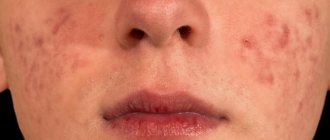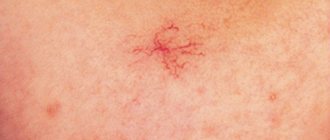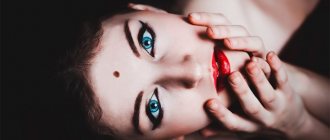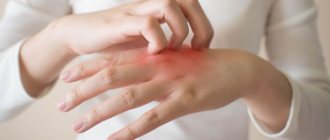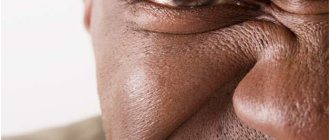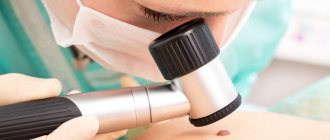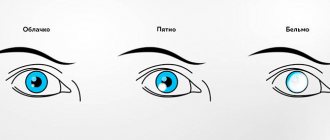There are no nerve endings in the liver tissue, so even in the “near-death” state it does not hurt. With cirrhosis, heaviness may be felt in the right hypochondrium, but does this symptom suggest thoughts of an incurable disease? However, a diseased liver still shows some signs. They are conventionally divided into large and small. “Large liver signs” are directly related to the liver, while “small” ones can indicate many other problems in the body. Still, the simultaneous appearance of even a few minor symptoms should prompt you to make an appointment with a doctor.
How not to turn your liver into foie gras. Simple and effective measures Foie gras is translated from French as fatty liver. This is what doctors colloquially call non-alcoholic fatty liver disease.
Causes of liver damage in women
Signs of a diseased liver in a woman appear due to exposure to negative factors.
Long-term interaction with toxic substances is especially dangerous for tissues. In the process, severe painful conditions arise in the form of hepatitis or cirrhosis. Toxic effects include:
- Regular alcohol consumption. Its frequent use leads to irreparable changes in liver tissue and destroys them. Often the disease takes life-threatening forms.
- Tissue damage due to drugs. Uncontrolled use of medications depletes liver cells, since toxic substances enter the body with medications. The most dangerous hepatoxic properties are those of antibiotics, hormones, and medications used in chemotherapy.
- Viral infections. They are viruses that cause hepatitis of any type (A, B, C). Infection with them is fraught with the development of prolonged inflammatory changes in the liver, destroying the organ and causing cirrhosis.
- Constant work in environmentally hazardous industries where there is contact with toxic elements and toxins. These are salts of heavy metals, acids and other chemicals. Toxic infection occurs gradually, but causes cell necrosis and renal failure.
What are the types of liver diseases?
According to statistics, over 200 million people all over the planet have experienced liver disease at least once in their lives. Problems with the filtering organ cause human death in every tenth case of death. In terms of mortality, hepatitis is equated to pulmonary tuberculosis and AIDS.
Most often, liver diseases occur due to viral infections, intoxication with toxic substances, and alcoholic beverages. Chronic pathologies become a predisposing factor in the complete degeneration of organ tissue, cirrhosis.
Hepatitis takes first place in the list of diseases, they can be:
- toxic;
- ischemic;
- viral.
The disease is also divided into acute and chronic forms.
With prolonged exposure to toxic substances, cirrhosis develops in the human body. This disease can be the result of genetic diseases, oncology of the hematopoietic system, necrotic processes.
Various benign and malignant neoplasms can develop in the liver. Doctors diagnose cancerous tumors of liver cells or metastasis from other internal organs, tissue abscesses, cysts.
Doctors say the cause of health problems is the appearance of infiltrates and functional disorders accompanied by jaundice. Often there are diseases associated with damage to the bile ducts within the organ itself:
- cholangitis;
- inflammation in the bile ducts;
- scar changes;
- complete or partial obstruction.
In medical practice, pathologies of the liver blood supply system are increasingly encountered: thrombosis, congestion, the formation of arteriovenous fistulas.
Changes in the skin due to disease
Life expectancy of the liver in liver cirrhosis
This pathology is characterized by a general deterioration in the condition of the skin. She may be too pale with pronounced blood vessels, especially on the face or abdomen. Common symptoms of problems with the liver and biliary tract are characterized by: stretch marks, swelling, scratching that does not heal for a long time, allergic reactions, the appearance of spots, eczema.
Spider veins
This is the name given to characteristic formations on the skin that occur during structural changes in the organ. In appearance, the neoplasms resemble small spiders; in the center there is an arteriole, from which vascular cords extend to the sides. Upon palpation, you can notice pulsations inside such stars. Liver stars can also appear in people who do not have any pathologies, due to overeating fatty foods, hypothermia, alcohol abuse, smoking and many other factors. The disease can be diagnosed if there are many stars, and they are localized in one specific area of the body, do not disappear over time and increase in size.
Most often, asterisks appear during hepatitis, poisoning, cirrhosis and pregnancy.
In cases of illness, a rash often appears. It can be acneous, with the formation of comedones, purulent, papular. A pustular rash most often appears on the face, chest and neck areas. It may indicate disturbances in the functioning of the gland and ducts due to poor nutrition or bad habits.
Allergic dermatoses occur most often with parasitic infections, as a reaction to decay products secreted by helminths. An allergic rash can occur due to an overdose of antibiotics or hormonal drugs.
Itching accompanies all skin changes associated with pathologies of the gland and ducts. It is the intensity of itching and scratching that may indicate the stage of the current disease.
Liver plaques
Appear due to chronic diseases. Externally, the plaques resemble traces of healed burns. They have a rounded shape; upon palpation, the edge is clearly felt. At the initial stage, plaques appear in the form of small red lumps that develop into blisters; when they burst, a red mark remains in their place, with a visible border and a whitish center.
An indicator of gastrointestinal health is the appearance of the tongue. In diseases that cause intoxication of the body, one can observe a greenish or yellow coating and cracks on the tongue, accompanied by an unpleasant, sour, rancid odor.
Age-related spots on the skin
The concept of “liver” spots refers not only to changes on the skin that appear as a result of liver diseases, but also age-related changes that are characterized by a violation of skin pigmentation. We will talk about them below. You can see what such spots look like in the photo below.
Age spots are called differently:
- senile;
- pigmented;
- solar (senile) lentigo;
- hepatic.
Moreover, the latter name has nothing to do with liver diseases, it’s just that age spots are distinguished by a brown rash, which in color resembles the shade of the liver.
On the surface of the skin, age spots can look like this:
- flat;
- slightly raised oval shape;
- in the form of light or brown plaques.
As a rule, such rashes appear in people over 40 years of age and are located on open areas of the skin:
- on the face;
- on hands;
- on the shoulders and forearm.
Basically, these heels are a consequence of aging and long-term exposure to ultraviolet rays. Many people confuse them with moles; they are also distributed throughout the body, including the face and hands, and the color of moles is also brown. Only a qualified dermatologist can distinguish lentigo from a mole.
spots and moles are mostly not dangerous and painless; they do not necessarily need to be treated, only if the doctor has prescribed their removal using laser or cryotherapy.
You should consult a doctor if the spots begin to change their appearance and shape. This will make it possible to prevent their degeneration into a malignant form in time.
Why does itching occur?
Types of allergic rashes (+ examples in the photo)
The skin itches due to bile stagnation in the body. Itching due to liver pathologies is combined with hepatic jaundice: in this case, the skin turns yellow. It takes 2-3 months from the moment the rash appears to jaundice: everything depends on the nature of the disease and the characteristics of the body. Rashes with itching during hepatitis indicate an exacerbation of the disease.
So, as mentioned above, the symptom occurs due to the fact that a large amount of bile acids remains in the blood. If the liver works smoothly, these acids are released along with bile
It is important to note that they affect the nerve endings in the skin, which causes a rash and itching. Unpleasant sensations worsen at night
Itching occurs due to the fact that the detoxification properties of the liver are disrupted. Thus, it cannot remove toxic components and breakdown products in sufficient quantities.
- Cholestasis. The cause of itching is cholestasis, in which the circulation of bile changes: fragments of these same acids penetrate into the blood. Skin rashes with cholestasis occur because the body does not actively produce bile. With cholestasis, there are difficulties with the excretion of bile: the cause may be blockage of the bile ducts or their compression from the outside.
- Damage to hepatocytes. Rashes and itching are observed when hepatocytes are damaged: the disease occurs due to infection, viral hepatitis or ailments caused by parasites.
- Toxins. The change in hepatocytes is caused by a toxic effect on the liver: the disease occurs in those who abuse alcohol, take drugs, as well as medications selected at their own discretion.
- Cirrhosis. Damage to hepatocytes also occurs in cirrhosis. As the disease progresses, pain occurs in the side and right hypochondrium. The functions of hepatocytes are disrupted, causing bile acids to penetrate into the blood. If a person is diagnosed with biliary cirrhosis, the disease will certainly manifest itself with itchy skin.
- Cholelithiasis. In most cases, cholestasis occurs due to blockage of the bile ducts.
- Cancer. The problem arises against the background of cancer: they lead to the fact that the bile ducts are compressed from the outside.
Itching and itchy spots
Almost all liver diseases are accompanied by itching on the epidermis. It especially manifests itself in combination with irritation and yellowness of the skin. This happens because bilirubin, which the liver should, but cannot, neutralize, lingers in the layers of the skin, irritating it. Thus, the body begins to itch due to stagnation of bile and, as a result, the occurrence of jaundice.
All skin rashes that appear on the skin as a result of liver disease, be it hives, plaques or red spots, are not without itching. It happens that itching occurs against the background of allergies, then in order to distinguish liver irritation from allergic irritation, you need to know that hepatic irritation is not eliminated by antiallergic drugs.
Features of treatment
Formations in the liver: what it can be, types of tumors
Therapy, if the patient has liver pigmentation, can be aimed at eliminating the cause that provoked its appearance. For this purpose, the functioning of the liver and all organs and systems is normalized. If this method does not give a positive result, then laser removal of areas of pigment accumulation or spider veins is indicated. Alternative medicine can be used as a complement to basic methods.
Treatment of the cause
The first stage of treatment is aimed at eliminating the cause of the skin defect.
Liver spots can be removed only after the functioning of all organs and systems has been normalized and the elimination of bilirubin breakdown products from the body has been enhanced. For this purpose, it is recommended to use hepatoprotectors “Essentiale” or “Phosphoglin”, which help restore hepatocytes and normalize blood flow in the liver. Also shown are agents that enhance the removal of toxins “Sirepar” and “Hepatosan”. The amino acids “Heptor” or “Heptral” will be useful.
Herbal products “Gepabena”, “Karsil” and “Hofitol” are also used. It is possible to treat gallstones using bile acid preparations, such as Ursofalk, Ursosan, Exhol and others. Patients must be prescribed a gentle diet, limiting the consumption of fatty, fried and spicy foods
It is important to get rid of bad habits - smoking and alcohol addiction, as well as avoid stress that puts stress on the liver
Traditional methods
In combination with drug and surgical treatment, non-traditional methods can be used. They help to significantly improve the patient’s condition and reduce the severity of pigmentation. One such method is rubbing aloe, calendula and orange juice into the pigment. This should be done 3 times a day for 2 weeks. Once a week you can apply a mask of cottage cheese, ammonia, lemon juice and white clay. Ice cubes containing frozen decoction of mint, chamomile and aloe pulp will also be useful. They need to be rubbed into your face in the morning.
Laser treatment
The advantage of the procedure is the quick result.
If it is not possible to eliminate liver stars, plaques or spots using medication, then surgical removal of these tissues is used. For this purpose, a laser is most often used. It causes minimal damage to the skin and leaves no scarring or wounds. This procedure is painful and is performed under local anesthesia. The effect is noticeable after several courses of laser removal of formations. At the same time, the problem in the liver remains and formations can develop again if their immediate cause is not eliminated.
Treatment of liver spots
The most important thing is that you should not self-medicate. If you have liver spots, you should definitely contact a specialist who will examine you and prescribe the correct treatment.
A large number of cosmetic companies offer various medications and cosmetics for removing stains. However, the problem is within you, and after some time they will return again. It is better to focus efforts on combating the source of the problem than to mask it.
The liver is an amazing organ. She is capable of self-regeneration even in the most advanced cases, so if you help her, recovery will go faster. You should take medications as directed by your doctor, undergo procedures and follow a diet. Treatment of any of the diseases is carried out in various ways:
- In case of cirrhosis, treatment is aimed at stopping the processes of decay of organ structures. It includes the use of medications and diet.
- To get rid of diseases of the gallbladder and its ducts, you need to methodically take choleretic drugs. Also, one of the methods of non-surgical treatment is remote ultrasound lithotripsy. However, if the stones are too large, then only surgery will help. Now medicine offers the most modern methods of removing stones: crushing them with a laser, endoscopic cholecystectomy or open abdominal surgery.
- If a person has parasites, they are treated with antiparasitic drugs. If they do not help, surgical excision is used, then restorative measures.
- In the case of hepatitis, antiviral medications and a strict diet are used.
One way or another, the best option is to turn to a professional, if only to avoid making things worse. After all, health is one thing, and you need to preserve it with all your might. Take care of yourself!
What to watch out for
Of course, the liver is extremely resistant to external influences. In addition, she has the ability to regenerate. But there are still factors that can cause diseases in the body’s laboratory.
Toxic substances. These include heavy metals and chemistry. With their constant intake into the body, various liver damage occurs. A single but sudden impact is also dangerous.
Viruses. Cause inflammatory processes in acute or chronic forms. Often the result of infection of the gland by viruses is hepatitis.
Alcohol. Excessive consumption of alcoholic beverages has a detrimental effect on liver cells. Often, uncontrolled alcohol consumption causes cirrhosis, a life-threatening disease.
Medications. The use of hormones, antibiotics, and chemotherapy drugs negatively affects the functioning of the liver.
Poor nutrition. Fatty, fried, smoked foods in excess quantities lead to disruption of the outflow of bile. Excessive consumption of spices can also lead to it. The result is the formation of stones in the bile duct.
Parasites and infections. The most dangerous are roundworms, alveococcus, and echinococcus. They act as sources of pathological changes in the organ and can cause its cystic transformation.
Abdominal diseases. Suppuration processes can spread to the portal vein of the liver. Thrombosis often occurs as a result of such disorders.
Heredity. Often the cause of diseases in the “laboratory of the body” are genetic diseases. Ionizing radiation, chemical carcinogens that promote liver cancer. Abdominal injuries
It doesn't matter how long ago you suffered a serious stroke or abdominal injury. Cysts or fluid accumulations in the liver parenchyma can be detected even after several years
Signs of pathologies
Diseases of one of the most important glands in our body are accompanied by skin symptoms. First of all, you can highlight the yellowish tint of the skin. Patients complain of nausea and heartburn. Sweating is increased, and the sweat has a pungent and extremely unpleasant odor. When visiting a medical facility based on these signs, the doctor can easily diagnose liver problems.
You should also think about visiting a doctor if the size of the gland is increased, pain and discomfort are felt in the area of the organ, weakness, swelling and headache are bothersome. Rash, itching, weight loss, unstable stool or changes in the characteristics of stool, bitter taste in the mouth, white or brown coating on the tongue, cracks on it are direct reasons for concern. A venous pattern on the abdomen, an enlarged abdomen, temperature, and acne also indicate the presence of diseases in the body.
How does your liver hurt?
Almost all pathologies of the gland are reflected on the human face and body. They are often accompanied by a feeling of pain. The nature of these sensations is very different:
- Minor pain in the right hypochondrium. As a rule, it has an aching or bursting character. It speaks of a sluggish inflammatory process. Discomfort is caused by stretching of the organ or enlargement of the liver capsule.
- Intense discomfort in the right hypochondrium. Quite a rare type of pain. Signals about a pronounced purulent-inflammatory process. In some cases, it appears with stones in the bile duct.
- Severe point pain in the liver area. Characteristic of pathology of the gallbladder or extrahepatic ducts.
However, with diseases of the “laboratory of the body” the patient does not always experience pain. As a rule, this is observed in the case of a sluggish disease that remains undetected for a long time. In the absence of pain, problems with the internal organ are indicated only by rashes on the skin.
Skin symptoms of GBS diseases
Spots on the skin in liver diseases are a characteristic symptom that appears at a certain stage of the disease, so it is often used to characterize development and determine the clinical picture. The appearance of liver spots is not the only modification of the skin. At the same time, changes in coloration, urticaria, complex scratching resulting from itching, rashes of various types, eczema and other evidence of disturbances of the largest organ complex in the human body are noted.
- Nature has provided the skin on the body of vertebrates as a large organ complex with numerous functions. Approximately 6% of the total mass of an adult is the weight of the skin, and its area varies, depending on individual characteristics, from one and a half to 2.3 square meters. m.
- The participation of the skin in the metabolism of metabolic processes, respiration, thermoregulation is designed to ensure the stability of the human body system in changing external conditions.
- Liver spots that appear on the skin are not only evidence of disturbances in the liver. Their frequent presence has been noted during malfunctions of the hepatobiliary system and digestive organs. Negative changes may occur due to the loss of the liver’s detoxification function, which is subsequently transferred to the skin. But by this time, the skin and hypodermis are almost unable to cope with their own responsibilities.
- The cause of negative changes can be both internal influences and the influence of ultraviolet radiation, aging processes, age-related degradation, which has reached the point of slowing metabolism.
- The proven relationship between the exchanges and transformations occurring inside and outside a person is undeniable; in the case of the liver, symptoms appear on the skin in the later stages. To a certain extent, spots on the body due to liver disease can be considered a direct consequence of loss of appetite and lack of intake into the body of food components, vitamins, minerals, and essential acids necessary for normal functioning. The other side of the coin in this case is the inability to digest the required amount of food that could be supplied.
- Disturbances in the functioning of internal organs inevitably affect metabolic processes, the ability to break down food bases, remove bilirubin and cholesterol, change the qualitative composition of bile and the formation of stones.
- Hence not only the appearance of lentigo and yellowing of the mucous membrane, skin and sclera with certain malfunctions. Urticaria or an allergic rash develops, caused by a reaction to the toxins present, which are no longer excreted by the liver, which has lost this ability.
Fact! Skin symptoms - from general changes to rashes, spots, dots, spider veins - are all an integral part of liver disease at a certain stage, and are not the only evidence of an irreversible process.
The appearance of spots on the skin due to liver diseases indicates that the pathological processes have advanced far enough and have even affected the external system for stabilizing the body in the constantly changing world around us. And this indicates a partial loss of the skin’s ability to keep the body in relative stability to external conditions.
Where do spots appear on the body due to liver disease?
With diseases of the gland, the skin becomes a non-standard color, and this should never be ignored. Yellowish skin with an orange color indicates internal liver problems; lemon tint - about hematological disorders; brown means mechanical damage to the organ.
Basically, liver spots are localized throughout the body, depending on the disease and its manifestations:
- Rash – face, neck, chest, back;
- Red spots – in the liver, abdomen;
- Yellow spots – oral cavity, sclera, with transition to other parts;
- Bright red spots – palms;
- Pigment spots – palms, arms, face, neck;
- Yellow plaques – armpits, eyelids, arms, legs, feet;
- Spider veins – neck, back, arms, face;
Each skin rash is accompanied by itching.
Treatment
Before starting any treatment, you should consult a doctor. After the examination has been completed and the cause has been established, the doctor will tell you how to remove spots on the body and how to get rid of pigmentation on the face. You can get rid of liver spots using various cosmetic and medicinal products that are applied externally. For coarser and more extensive spots, the doctor will prescribe medications to cleanse the liver, hepatoprotectors, with the help of which it will be possible to prevent further spread of pigmentation and reduce the severity of existing lentigines.
Therefore, it is very important to first get rid of the cause of this phenomenon, and only then begin treatment. In addition, if the underlying cause is eliminated, the pigmentation may disappear on its own.
The most common methods for removing lentigo include:
You can get rid of liver spots using various cosmetics and medications.
- the use of special pharmacy creams, the task of which is to lighten spots;
- the use of traditional methods - cucumber, oat masks;
- use of liquid nitrogen;
- photo stain removal;
- rejuvenation procedures – mesotherapy;
- laser removal;
- chemical peeling (salicylic, retinoic, Jessner).
Folk remedies
Unconventional methods can also help lighten your skin. They can be used along with pharmacy whitening creams. You can lighten pigmentation using the following means:
- Sorrel. A mask of crushed pulp is applied to the face for 20 minutes. Do this procedure at intervals of 2 days.
- Chickweed. Prepare a decoction based on the plant, wipe your face with it morning and evening.
- Avocado. You can use crushed fresh fruit pulp as a mask. Or you can buy an avocado extract at the pharmacy and lubricate your face with cosmetic oil every day.
- Papaya. With the help of fruit enzymes, pigmentation is effectively lightened. Grind or crush the pulp and apply as a mask. Repeat several times a week.
- Lemon. Squeeze lemon juice and mix with egg white in equal parts. Apply to skin using a cotton pad.
- Onion juice and apple cider vinegar. Mix the components and apply to the epidermis.
Laser stain removal
Using modern methods, liver spots can be removed quickly and painlessly
Using modern methods, liver spots can be removed quickly and painlessly. More than one procedure will be required. Laser polishing is carried out in the autumn-winter period, when solar activity is low.
This procedure is carried out only in specialized institutions. After three procedures, the first effect will be visible. At the same time, the root cause of the problem should be eliminated.
What are the symptoms of a diseased liver
Liver disease initially does not have any symptoms, which is dangerous for the body, because sometimes the disease is recognized at a very advanced stage. The first symptoms most often concern the digestive system.
First, it weakens, and then there is a lack of appetite, sometimes an aversion to fatty foods, weight loss, a feeling of oversaturation after eating, poor tolerance of fats and alcohol, abdominal pain (especially on the right side in the liver area), unpleasant belching after eating and nausea.
Further signs and symptoms of liver disease are much more serious and include:
- jaundice - yellow discoloration of the mucous membranes of the sclera and skin, resulting from too high levels of bilirubin in the blood plasma;
- hepatomegaly (increase in the size of the gland) - can be a symptom not only of its insufficiency, but also of hepatitis, Budd-Chiari syndrome, liver tumor, infectious mononucleosis and drug-induced liver damage;
- joint pain;
- chronic fatigue, problems with concentration, worsening exercise tolerance;
- muscle atrophy, especially observed with long-term cirrhosis;
- abnormal blood clotting;
- cholestasis – improper flow of bile;
- swelling around the ankles;
- varicose veins of the esophagus and rectum;
- enlargement of the abdomen as a result of ascites - excessive accumulation of fluid in the abdominal cavity;
- gynecomastia is a problem for men, based on pathological enlargement of the mammary glands, often with a change in the color of the nipples to a lighter (female) color;
- Women may suffer from menstrual disorders as a result of liver disease.
Some patients claim that they experience liver pain after eating. This type of discomfort usually indicates problems with the gallbladder. Unpleasant sensations usually occur after heavy fatty and fried foods, especially in people with inflammation of the gallbladder or gallstone disease.
"Small liver signs"
Usually a person does not pay attention to “minor liver signs” for a long time, because they are not significant. Rarely does anyone associate them with the condition of the liver, except gastroenterologists and hepatologists:
- Telangiectasia - spider veins. Among the reasons for their appearance: chronic varicose veins, rosacea, systemic connective tissue diseases, endocrine disorders, and liver pathologies. Stars on the legs are usually a sign of varicose veins, but telangiectasias on other parts of the body - in the area of the wings of the nose, chin, cheeks, buttocks - usually appear due to other problems, including the liver;
- Xanthelasmas are flat, yellowish cholesterol plaques that are visible under the skin. They can appear on any part of the body, but they are most visible in the eyes. They occur both with congenital disorders of lipid metabolism and against the background of acquired diseases: diabetes mellitus, hypothyroidism, pancreatitis, hepatitis and cirrhosis of the liver.
- Palmar or plantar erythema – bright pink palms and/or soles. This symptom is also called liver palms (spots appear much less frequently on the feet). The palms turn red symmetrically, the rash appears in the form of small spots. If you press on the reddened area, it disappears, but after a while it appears again. Palmar erythema in liver disease may be accompanied by increased fatigue, weakness, and a slight increase in body temperature. It can also be a symptom of other problems in the body: excess vitamin A, deficiency of vitamin B, contact dermatitis, tuberculosis, thyroid pathologies, etc.;
- Leukonychia - white spots and stripes on the nails. Many people believe that the main reason for whitening nails is a lack of trace elements (for example, zinc). But in fact, the range of reasons is much wider. Leukonychia can appear against the background of infections, metabolic problems, kidney and liver diseases, anorexia and constant stress;
- Gynecomastia is enlargement of the mammary glands in men. It can develop not only with hormonal disorders, but also with liver cirrhosis;
- Testicular atrophy. This pathology often occurs due to inflammatory and infectious processes, injuries, testosterone replacement therapy and the use of anabolic steroids. But severe liver disease, kidney disease and hemochromatosis also predispose to testicular atrophy;
- Hypertrophy of the parotid glands;
- Capillary network on the face.
If you have more than one of the signs on this list, see your doctor and ask for a liver test (liver enzyme test and ultrasound). Such symptoms do not arise “out of the blue” in any case. It will not hurt to find out what is happening to the body and how to help it.
Types of rashes
External manifestations of a problem with an internal organ are not limited to the appearance of only smooth spots. The changes are not always pigmented - sometimes vascular changes form in the epidermis. So what kind of rash occurs in liver diseases and how does it occur?
Types of changes:
- Allergic dermatitis. Toxins cause skin disorders (reminiscent of urticaria), but with severe disorders it is aggravated by boils.
- Liver stars. With chronic dilatation of small vessels, which is called telangiectasia, spider veins up to 0.5 cm in diameter grow on the body. They rise above the skin and resemble spider legs.
- Dermal stretch marks. The changes are similar to stretch marks that occur after pregnancy, but have a blue tint. Often found on the stomach and sides.
- Purpura. Subcutaneous hemorrhages can be both small and large. When pressed, they do not temporarily disappear.
If rashes and spots on the skin due to liver diseases occur simultaneously with an enlarged abdomen, then there is a high risk of fluid accumulation under the organ. This condition is called ascites, and it occurs with cirrhosis.
Liver palms are a condition that additionally indicates the development of liver cirrhosis. The main symptom is severely reddened skin of the upper extremities.
ethnoscience
Liver cleansing is a therapeutic procedure intended for those who are interested in how to get rid of brown rashes on the dermis.
Recipes:
- Cottage cheese, ammonia and curd mass. All ingredients are mixed (the mass sizzles - this is normal). Application time: 10–20 minutes.
- Cream and lemon. Mix 1:1 cream and citrus fruit, and then rub the mixture into darkened areas. Lemon helps discolored areas of the body lighten. It is better not to treat red rashes in this way: their appearance is associated with a defect in the vessel, which cannot be bleached. Avocado and papaya are also used instead of lemon, and white clay is used instead of cream.
- Sorrel. To reduce pigmentation, turn the leaves into a paste and then apply them to problem areas of the body for 20–30 minutes.
- Elder. 6 inflorescences are poured with 300 ml of boiling water for 30 minutes and then cooled. Apply with cotton wool up to 5 times a day (on hands and other parts of the body).
- Aloe or onion juice. By moisturizing the dermis with plucked leaves or scales, a person eliminates the rash, especially if it resembles allergic dermatitis.
To eliminate large rashes, treatment with folk remedies is not always effective; in such a situation, it is better to consult a doctor. Serious lesions, and especially cirrhosis, are treated exclusively in hospital settings.
! Drinking lemon water in the morning is a way to eliminate chronic intoxication in the body.
Help in the clinic
To find out how to remove the rash, you need to check your liver - take tests and undergo an ultrasound. After diagnosis, the therapist prescribes medications that have cleansing properties.
Medicines for renewing liver cells (hepatoprotectors):
- Ovesol;
- Hepatrin;
- Detoxical;
- Karsil;
- herbal liver collection.
To speed up the release of bile from the bladder, Xylitol, Cholemax, and Berberine sulfate are prescribed. For hepatitis - Cycloferon, Viferon, Ribavarin.
Even after successful treatment, some of the rashes remain, so removal is the last chance to get rid of the aesthetic defect.
Options for mechanical elimination of pigmented and vascular rashes:
- cryodestruction;
- photodynamic therapy;
- laser removal;
- face resurfacing;
- mesotherapy.
To eliminate liver stars, doctors prescribe sclerotherapy (a medicinal substance is injected under the skin). It is better not to agree to excision with a scalpel: the outdated procedure, which is still used in public clinics, leads to the formation of strong depressions in the skin. It makes more sense to choose more modern correction methods.
Conclusion
Any spots on the skin due to liver diseases can be removed using modern methods, but the procedure for affecting the skin does not solve the main problem. It is associated with a disorder of the endocrine gland.
After undergoing the study, the patient has the opportunity to restore health and prevent the appearance of new dark rashes on the skin.
Folk remedies
There are many witchcraft recipes to overcome liver disease. Be sure to discuss symptoms and treatment with folk remedies with your doctor.
The most popular methods are:
Oats. You will need 2 tbsp. spoons of unrefined grain. Fill the component with a liter of water. Boil the ingredients over low heat for 15-20 minutes. Then add 2 tbsp to the contents. spoons of milk (preferably goat milk). This product should be boiled for another 5 minutes. Then strain the resulting broth and add honey (2 tablespoons) into it. Should be consumed half an hour before meals three times a day, 1/3 cup. Treatment with this remedy should last two weeks. Herbal decoctions. Traditional medicine advises choosing plants with yellow flowers. For liver diseases, herbal decoctions of St. John's wort, immortelle, chamomile, tansy, and milk thistle are useful. You will need 1 tbsp. spoon of herb per 1 cup of boiling water. The composition should be boiled for 1-2 minutes over low heat. After straining, the decoction is ready. Drink it half an hour before meals three times a day, 1/3 cup. As a rule, the course of treatment lasts about 10 days.
Follow all your doctor's recommendations and stay healthy!
Skin changes caused by liver diseases
What external symptoms indicate disease?
The liver in the human body plays the role of a kind of filter that works tirelessly to protect the body. And if a malfunction occurs in its work, the organ often calls for help with changes in the skin.
The most common symptoms are:
skin itching, called cholestatic; jaundice; telangiectasia; hemorrhagic manifestations; palmar erythema; pigmentation disorders.
Jaundice
Cholestatic itching is a sign of excess presence of bile acids in the blood. It can be either constant or periodic, but it is always very debilitating. The cause may be cholestasis syndrome.
Yellow discoloration of the skin caused by increased bilirubin is called jaundice.
Telangiectasia is spider veins with a red color indicating liver disease. Such manifestations are observed in the face, neck, and shoulder girdle.
Hemorrhagic spots are also called hepatic purpura. They appear as small hemorrhages that temporarily disappear with pressure.
Palmar erythema is characterized by a red coloration of the palms, also known as hepatic palms. This symptom indicates the presence of a chronic organ disease.
In addition to these manifestations, liver pathology is indicated by symptoms such as hepatic tongue (discoloration and swelling), the characteristic odor of the patient’s skin and breath, allergic and pustular dermatitis.
Liver diseases cause damage to nails and hair, their thinning and fragility. Hair becomes thin and prone to loss.
Pigmentation disorders in liver pathologies accompany almost every chronic disease of the organ. The mechanism of this phenomenon is not fully understood. Some scientists believe that its cause is damage to the parenchyma and difficulty in the filtration ability of the liver. In this case, the skin in the armpits and palms has a characteristic bronze or dirty gray color. Focal hyperpigmentation (chloasma) is expressed by the presence of age spots on the face and neck, usually in women.
